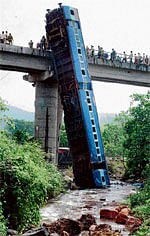
Another train derailment, 65 dead. Everyone reacts with anger; the usual blame game, Railways announce some cash relief. The present day price for the life of a major rail accident victim is Rs 5 lakhs and a vague rail job offer to next of kin. Enquiry ordered.
Matter over, rail business moves on. Unfortunately in most of the densely populated developing countries, including India, loss of human lives may not impact as much as it does in developed countries. That is why Indian Railways' existing safety policies are never impacted by either the frequencies or enormities of rail accidents. Now the question is whether IR should make some drastic rethinking on their approach to rail safety?
Since 2002-03, the Indian Railways have focused on shoring up their revenues, adopting multiple strategies. Longer passenger trains and heavier freight trains helped cater to the increase in demand for passenger services and afford economies of scale. However, introduction of several hundreds of new passenger trains and heavier freight trains year after year, on many of the busy routes, demands more intensified track maintenance.
Routes being heavily occupied, even nominated daily traffic blocks are curtailed. Till Dedicated Freight Corridors emerge, in several of the oversaturated routes, trains will continue to run under increasingly risky operating conditions. Vision 2020 repeats the same, familiar safety policy prescriptions, contained in tenth and eleventh 5 year Plan documents. Since most of these within the box thinking have failed to deliver, it is now time to think of railway safety, the way Richard Branson did with his Virgin Trains in UK.
Like Branson's Virgin Train Operating Company, we too need trains that should be able to survive accidents at full speed, regardless of cause and passengers should be able to safely walk out of coaches at accident spots. In existing bogie designs, at the time of accidents, one coach tends to ride over the other one, crushing the coach in front.
Surprisingly Branson’s zero fatality passenger coach specifications were dominantly original equipment manufacturer agnostic, unlike what others practice. We have to now decide to build, exceptionally strong coaches, while keeping down the weight.
Archaic design
Existing bogie designs match the 1950s, when train speeds were lower and train lengths shorter. Increase in train length from 18 to 24 coaches implies that, travelling at speeds of 100 km and above (as in the case of Kalka Mail which was said to be travelling at 108 km/h), there is a larger mass and thus momentum to contend with in any mishap during the run. When this huge mass has to be suddenly halted and its associated kinetic energy dissipated in accident conditions, the existing braking systems are also found seriously wanting, and sudden braking action in emergency, leads to massive loss of life/injury due to avoidable events like coaches jack knifing or climbing on to one another or turning turtle.
Frequent derailments on IR indicate that the time has come to make changes in coaches beyond riding comfort improvements and address more critical issues like lighter coaches, design changes to absorb impact of high speed collision, better braking and signaling systems etc for safe operations of our longer, faster and heavier trains.
Indian Railways appear to be slipping on many other fronts too when it comes to safe operations. The introduction of semi heavy haul/higher axle load train operation by migrating from 20.9 t to 22.9 t axle load, and overcrowding the same route line capacity with more and more passenger trains, demands a rigorous inspection regimen.
Instead of intensifying the inspection regimen, inspections have continued to be dangerously inadequate. Owing to inadequate manpower, patrolling of track, to detect rail fractures and possible sabotage activities is woefully short of required level of intensity. In safety categories alone, like gangmen, pointsmen, signalmen, assistant station masters etc, there are more than 60,000 vacancies.
Commercialisation
Focus on commercialisation of the Railways has to some extent been at the cost of importance given to vital skills required to run the railways, in particular, engineering, equipment/rolling stock maintenance and train operations skills. These core functions whose effective coordination underlies safety performance tend to take a back seat in the focus on chasing commercial targets. Another disturbing trend is placement of officers who have inadequate expertise as DRMs and GMs. Lack of expertise, has led to serious errors in judgment, avoidance of intense inspection regimens resulting in serious compromise of safe operations and maintenance of rail systems.
As of now Depreciation Reserve Fund is the only fund available for rehabilitation of aging track and signaling infrastructure, rolling stock etc. In an effort to artificially exaggerate the Operating Ratio, the Board has been avoiding adequate appropriation of cash to DRF, which in recent years, has exposed Railways to serious safety risks.
After a prolonged period of railways decline, it is the present Prime Minister who initiated a massive rail revival programme in India, backed by bounteous capex support of more than Rs 2 lakh crore, in the 11th plan. This also envisaged new locomotive and coach factories. The coach factory recently commissioned in Rae Bareily was a good opportunity to bring in new technology and coach designs with added safety features, rather than cloning the existing technology of RCF, Kapurthala at Rae Bareily. Precious Plan funds have been wasted.
Related Stories:
Rail safety, a long haul
Mamta-di derailed railway portfolio?
Deccan Herald is on WhatsApp Channels| Join now for Breaking News & Editor's Picks